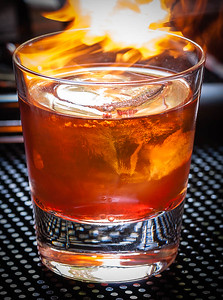Last time, contemplating Trader Vic’s Fog Cutter, I pondered the risks of combining multiple spirits—“too many spirits”—in cocktails, and the fine line between great cocktails and trainwrecks.
So it was an interesting moment for my first encounter with the Libertine.
The Libertine explores that fine line between greatness and identity crisis—part whiskey, part gin, with doses of bitters, sweet vermouth and Bénédictine. With only two main spirits, it’s hardly as suspicious as the Fog Cutter, but I was not expecting great things. Libertine won the bet—in the end, it retains its identity: a sweet, strongly bittered whiskey Old-Fashioned.
The name “Libertine” has been used for cocktails before; this one is another of Johnny Michaels’s creations, for the Libertine bar and restaurant in Minneapolis. Michaels’s cocktail menus always seem to include imaginative spins on the classic Old-Fashioned recipe, and his Libertine continues the tradition.
The bar menu specifies some of the ingredients: “Bulleit rye, Sapphire gin, sweet vermouth, Benedictine, bitters,” so we really have a leg up on reconstructing the drink. On the other hand, the bartenders are very close-mouthed about their eponymous flagship cocktail; important things like proportions, and just which vermouth and bitters are at work here, are not part of the discussion.

Deciphering this one takes a little extra work; as my bride says, “It’s research…” So I had to make a lot of almost-Libertines before I got to this one, which works quite well:
(Based on Johnny Michaels, Libertine restaurant and bar, 2014)
- 1 oz rye whiskey (Bulleit rye)
- 1 oz London Dry gin (Bombay Sapphire)
- ½ oz sweet vermouth (Carpano Antica)
- ½ oz Bénédictine
- ½ tsp bitters (Fee Bros. Old Fashion Aromatic)
- ¼–½ oz Demerara syrup (optional, to taste)
Stir with ice until cold. Strain into an iced rocks or Old-Fashioned glass. Garnish with flamed and heated orange peel.
The Bénédictine, reinforced by the vermouth, delivers just about as much sweetness as you’d find in a classic Old-Fashioned. I recommend one of the sweeter vermouths, something like Carpano Antica, with its vanilla and orange notes. The Bénédictine’s grassiness is entirely lost in the combination; its other herbal notes blend completely with the vermouth, and the combination works much the way straight vermouth works with rye in a Manhattan. It’s a far more sophisticated sweetener than straight sugar.
Including vermouth is as intriguing as including gin, and muddies the waters for people like me who like to categorize their drinks—it nudges the styling into the middle ground between the Old-Fashioned and the Manhattan, and you could argue the heritage from either direction. (I’m sticking with the Old-Fashioned.)
The bar’s version of the Libertine tastes sweeter than small amounts of Bénédictine and sweet vermouth could achieve; it tastes like there’s a bit of flavor tuning going on, with some unlisted additional sugar in the mix. The idea, I suspect, is that extra sweetness makes the cocktail, with its whiskey and large dose of spice, more palatable to some drinkers. Probably a good strategy for a namesake cocktail; I’m inclined to omit it at home.
I had expected a fistfight between gin and whiskey, so I was surprised and delighted with how well the two combined. The flavor is dominated by the rye whiskey, but there is the faintest aftertaste of the gin’s juniper, smuggled along in the background. The Sapphire gin is a key to this trick—it has a clean, vaguely peppery brightness without an overpowering juniper flavor, and seems to blend very well with the mild spiciness of the rye.
 The garnish is inspired by the classic “flag” of orange and cherry; in this case, the orange peel is roasted a bit, and included separately from the cherries. The bar at Libertine doesn’t actually flame the orange peel; I do, because it’s fun and theatrical, and where would we be without a little showmanship, I ask you.
The garnish is inspired by the classic “flag” of orange and cherry; in this case, the orange peel is roasted a bit, and included separately from the cherries. The bar at Libertine doesn’t actually flame the orange peel; I do, because it’s fun and theatrical, and where would we be without a little showmanship, I ask you.
The Libertine bar’s menu doesn’t specify the type of bitters at work here. There is a very strong note of cinnamon that reminds me of Fee’s Old-Fashion Aromatic Bitters, and plenty of it. Half a teaspoon is a lot of dashes, but the aggressive, cinnamon bitterness is part of the drink’s flavor profile.
In the end, I was right that rye and gin are unlikely partners, but I was wrong (again) in my suspicion that the combination was doomed. When will I ever learn? One of my favorite things about cocktails is that there is always another thing to discover, and another surprise to upset your preconceived notions.
“The Libertine” at cold-glass.com : All text and photos © 2014 Douglas M. Ford. All rights reserved.

I enjoyed the Libertine, but couldn’t really taste the gin. So tonight I made a Ragged Company (very close to the Libertine but without the gin). Instead of a couple of dashes of Angostura I used the 1/2 tsp. of Fee Bros. Very tasty and possibly indistinguishable from the Libertine. More research is required.
Yes, the gin is pretty subtle in this mix. Some of the more piney and juniper gins might show more strongly. I’m glad you enjoy the Libertine, and as you say, “More research is required.”